A Comparative Study: Uber, Big Data, E-commerce, and UK Taxi Industry
VerifiedAdded on 2020/04/01
|15
|2745
|218
Report
AI Summary
This report investigates the profound impact of Uber's e-commerce model, underpinned by big data analytics, on the UK taxi industry. It presents a comparative analysis between Uber and traditional taxi services, highlighting the disruptive effects on the market. The research explores the advantages and disadvantages of Uber's e-commerce approach, focusing on customer satisfaction, employment, and the influence of big data in understanding consumer behavior. The study employs a quantitative research design, utilizing questionnaires to gather primary data from both Uber and traditional taxi users. Key findings indicate a significant shift in customer preference towards Uber due to its convenience, competitive pricing, and data-driven services. The research also addresses the limitations, including concerns about data privacy and the impact on traditional taxi drivers. The conclusion emphasizes Uber's market dominance, the benefits to consumers and the economy, and the validation of the hypothesis regarding the transformative influence of e-commerce on the UK taxi industry.
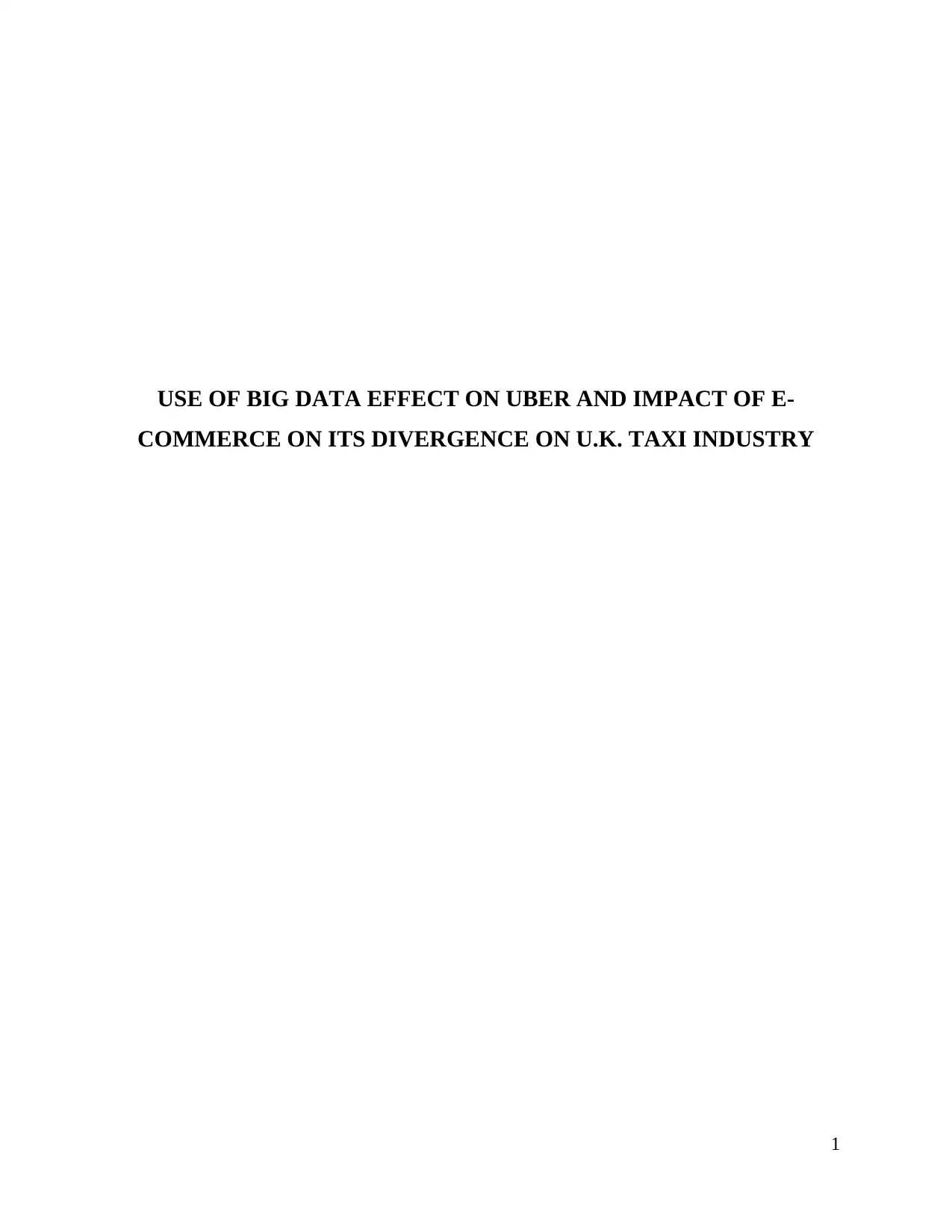
USE OF BIG DATA EFFECT ON UBER AND IMPACT OF E-
COMMERCE ON ITS DIVERGENCE ON U.K. TAXI INDUSTRY
1
COMMERCE ON ITS DIVERGENCE ON U.K. TAXI INDUSTRY
1
Paraphrase This Document
Need a fresh take? Get an instant paraphrase of this document with our AI Paraphraser
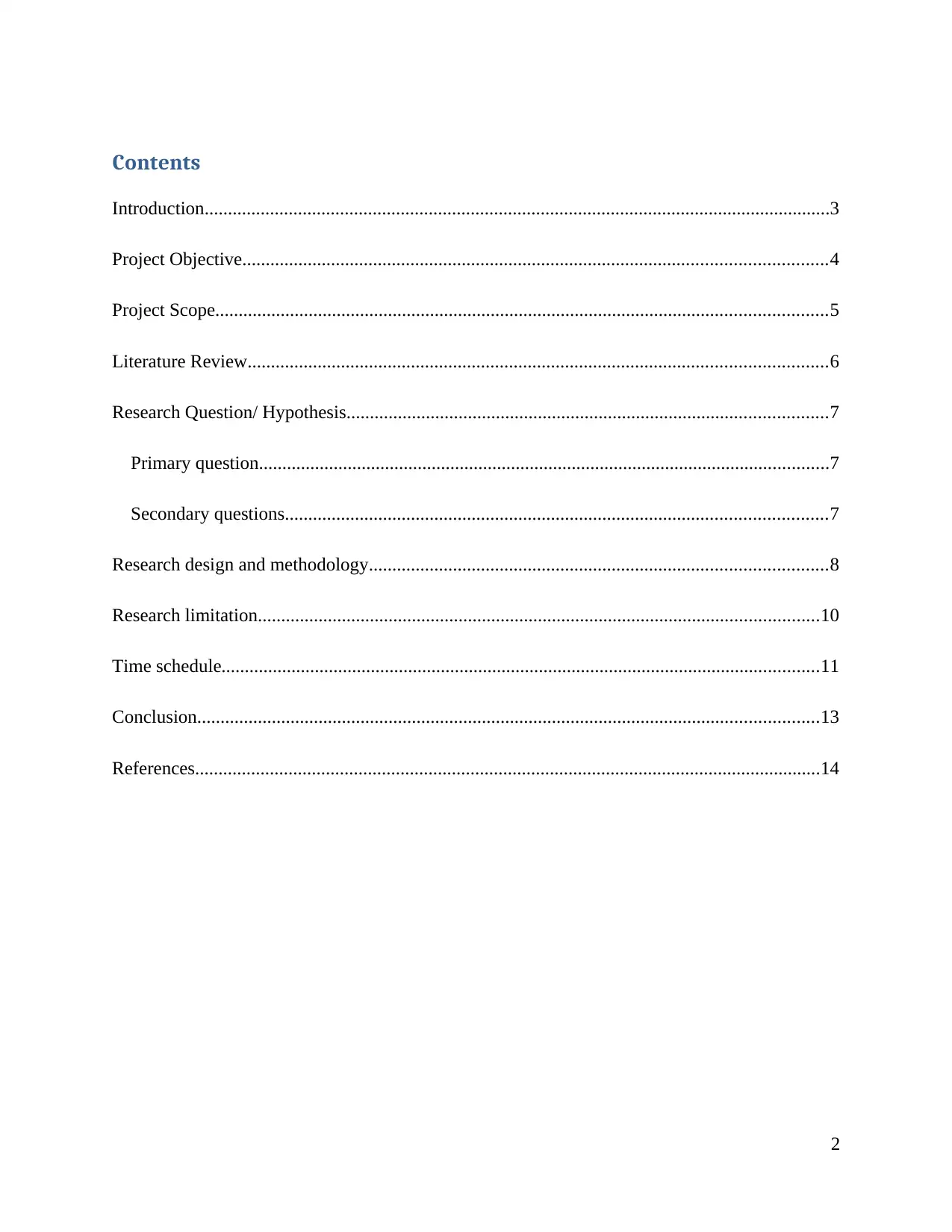
Contents
Introduction......................................................................................................................................3
Project Objective.............................................................................................................................4
Project Scope...................................................................................................................................5
Literature Review............................................................................................................................6
Research Question/ Hypothesis.......................................................................................................7
Primary question..........................................................................................................................7
Secondary questions....................................................................................................................7
Research design and methodology..................................................................................................8
Research limitation........................................................................................................................10
Time schedule................................................................................................................................11
Conclusion.....................................................................................................................................13
References......................................................................................................................................14
2
Introduction......................................................................................................................................3
Project Objective.............................................................................................................................4
Project Scope...................................................................................................................................5
Literature Review............................................................................................................................6
Research Question/ Hypothesis.......................................................................................................7
Primary question..........................................................................................................................7
Secondary questions....................................................................................................................7
Research design and methodology..................................................................................................8
Research limitation........................................................................................................................10
Time schedule................................................................................................................................11
Conclusion.....................................................................................................................................13
References......................................................................................................................................14
2
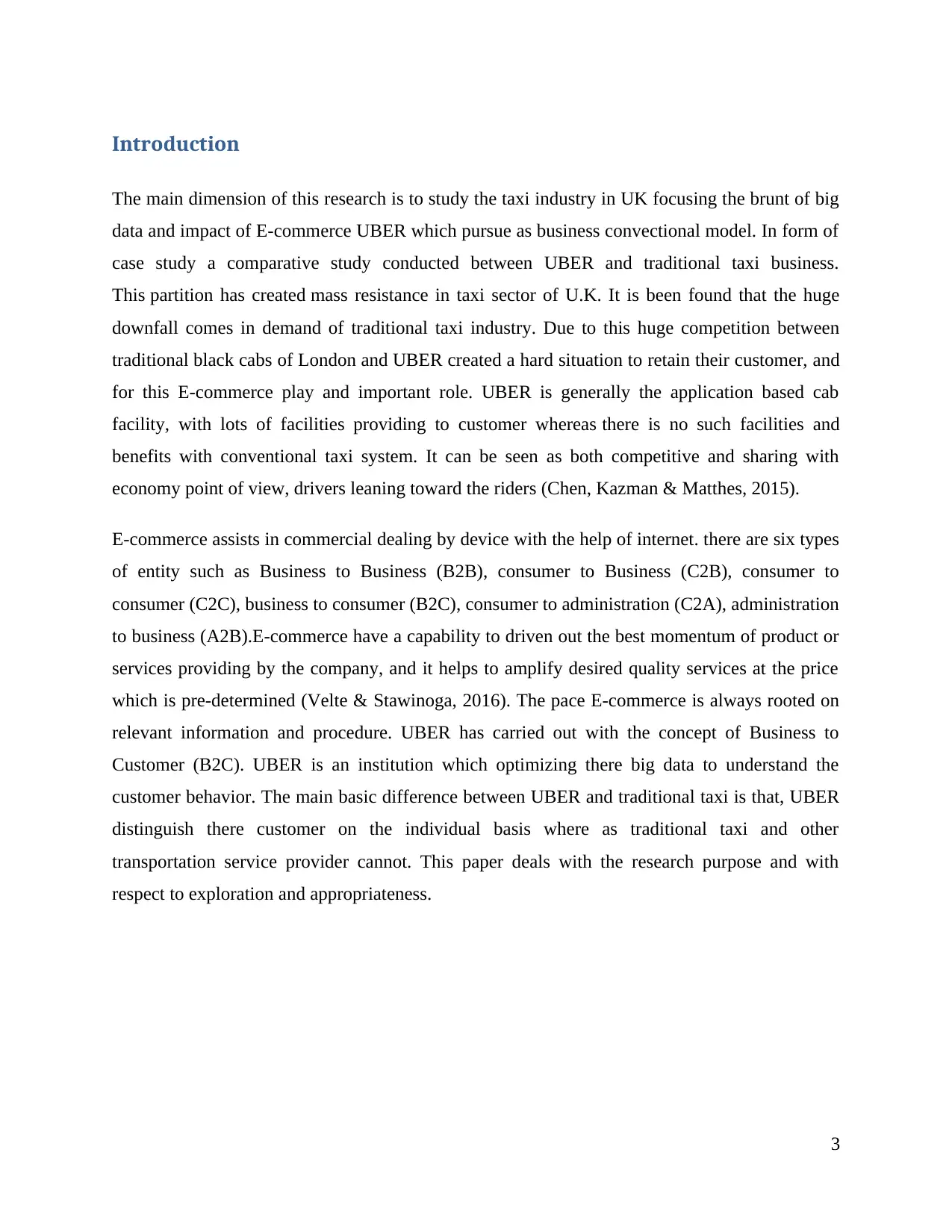
Introduction
The main dimension of this research is to study the taxi industry in UK focusing the brunt of big
data and impact of E-commerce UBER which pursue as business convectional model. In form of
case study a comparative study conducted between UBER and traditional taxi business.
This partition has created mass resistance in taxi sector of U.K. It is been found that the huge
downfall comes in demand of traditional taxi industry. Due to this huge competition between
traditional black cabs of London and UBER created a hard situation to retain their customer, and
for this E-commerce play and important role. UBER is generally the application based cab
facility, with lots of facilities providing to customer whereas there is no such facilities and
benefits with conventional taxi system. It can be seen as both competitive and sharing with
economy point of view, drivers leaning toward the riders (Chen, Kazman & Matthes, 2015).
E-commerce assists in commercial dealing by device with the help of internet. there are six types
of entity such as Business to Business (B2B), consumer to Business (C2B), consumer to
consumer (C2C), business to consumer (B2C), consumer to administration (C2A), administration
to business (A2B).E-commerce have a capability to driven out the best momentum of product or
services providing by the company, and it helps to amplify desired quality services at the price
which is pre-determined (Velte & Stawinoga, 2016). The pace E-commerce is always rooted on
relevant information and procedure. UBER has carried out with the concept of Business to
Customer (B2C). UBER is an institution which optimizing there big data to understand the
customer behavior. The main basic difference between UBER and traditional taxi is that, UBER
distinguish there customer on the individual basis where as traditional taxi and other
transportation service provider cannot. This paper deals with the research purpose and with
respect to exploration and appropriateness.
3
The main dimension of this research is to study the taxi industry in UK focusing the brunt of big
data and impact of E-commerce UBER which pursue as business convectional model. In form of
case study a comparative study conducted between UBER and traditional taxi business.
This partition has created mass resistance in taxi sector of U.K. It is been found that the huge
downfall comes in demand of traditional taxi industry. Due to this huge competition between
traditional black cabs of London and UBER created a hard situation to retain their customer, and
for this E-commerce play and important role. UBER is generally the application based cab
facility, with lots of facilities providing to customer whereas there is no such facilities and
benefits with conventional taxi system. It can be seen as both competitive and sharing with
economy point of view, drivers leaning toward the riders (Chen, Kazman & Matthes, 2015).
E-commerce assists in commercial dealing by device with the help of internet. there are six types
of entity such as Business to Business (B2B), consumer to Business (C2B), consumer to
consumer (C2C), business to consumer (B2C), consumer to administration (C2A), administration
to business (A2B).E-commerce have a capability to driven out the best momentum of product or
services providing by the company, and it helps to amplify desired quality services at the price
which is pre-determined (Velte & Stawinoga, 2016). The pace E-commerce is always rooted on
relevant information and procedure. UBER has carried out with the concept of Business to
Customer (B2C). UBER is an institution which optimizing there big data to understand the
customer behavior. The main basic difference between UBER and traditional taxi is that, UBER
distinguish there customer on the individual basis where as traditional taxi and other
transportation service provider cannot. This paper deals with the research purpose and with
respect to exploration and appropriateness.
3
⊘ This is a preview!⊘
Do you want full access?
Subscribe today to unlock all pages.

Trusted by 1+ million students worldwide
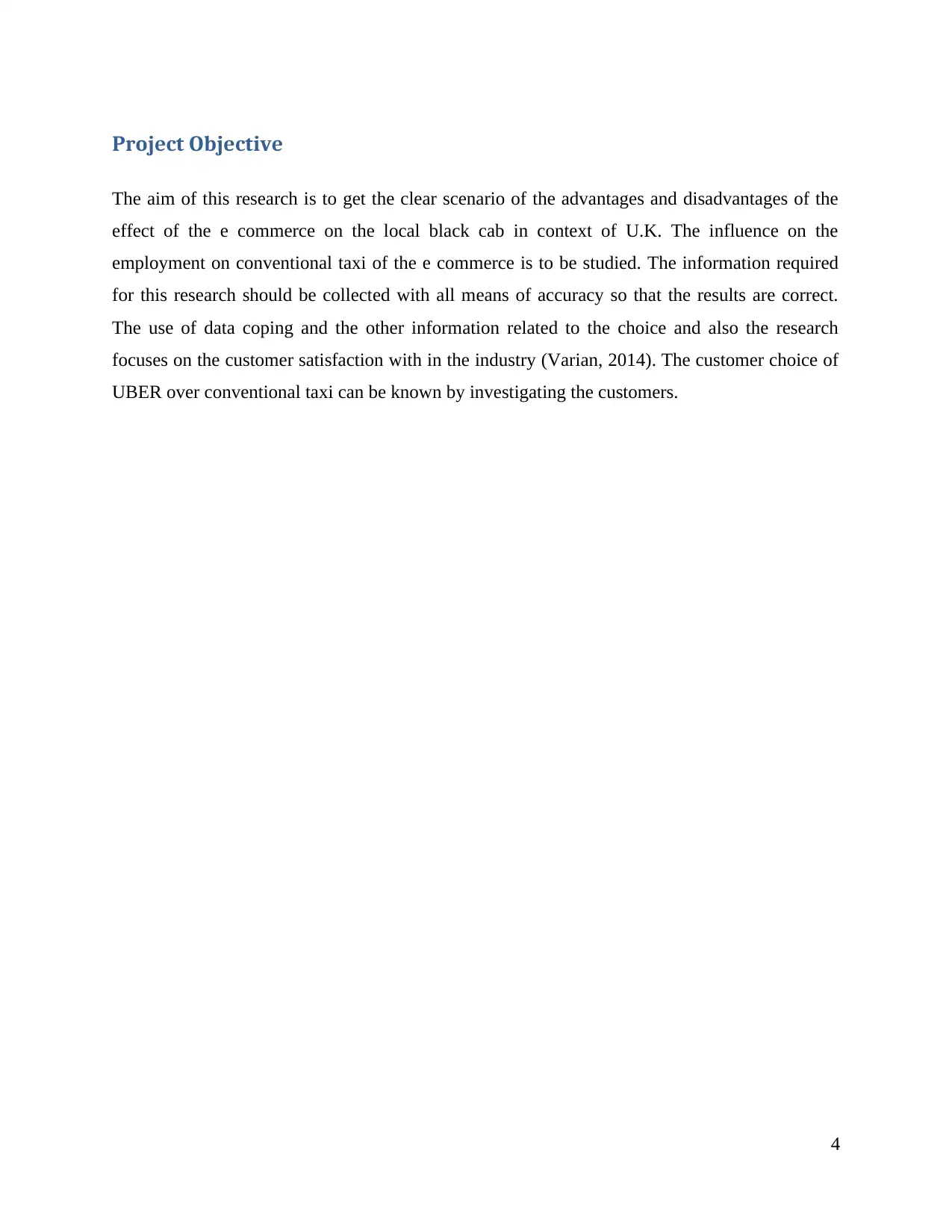
Project Objective
The aim of this research is to get the clear scenario of the advantages and disadvantages of the
effect of the e commerce on the local black cab in context of U.K. The influence on the
employment on conventional taxi of the e commerce is to be studied. The information required
for this research should be collected with all means of accuracy so that the results are correct.
The use of data coping and the other information related to the choice and also the research
focuses on the customer satisfaction with in the industry (Varian, 2014). The customer choice of
UBER over conventional taxi can be known by investigating the customers.
4
The aim of this research is to get the clear scenario of the advantages and disadvantages of the
effect of the e commerce on the local black cab in context of U.K. The influence on the
employment on conventional taxi of the e commerce is to be studied. The information required
for this research should be collected with all means of accuracy so that the results are correct.
The use of data coping and the other information related to the choice and also the research
focuses on the customer satisfaction with in the industry (Varian, 2014). The customer choice of
UBER over conventional taxi can be known by investigating the customers.
4
Paraphrase This Document
Need a fresh take? Get an instant paraphrase of this document with our AI Paraphraser
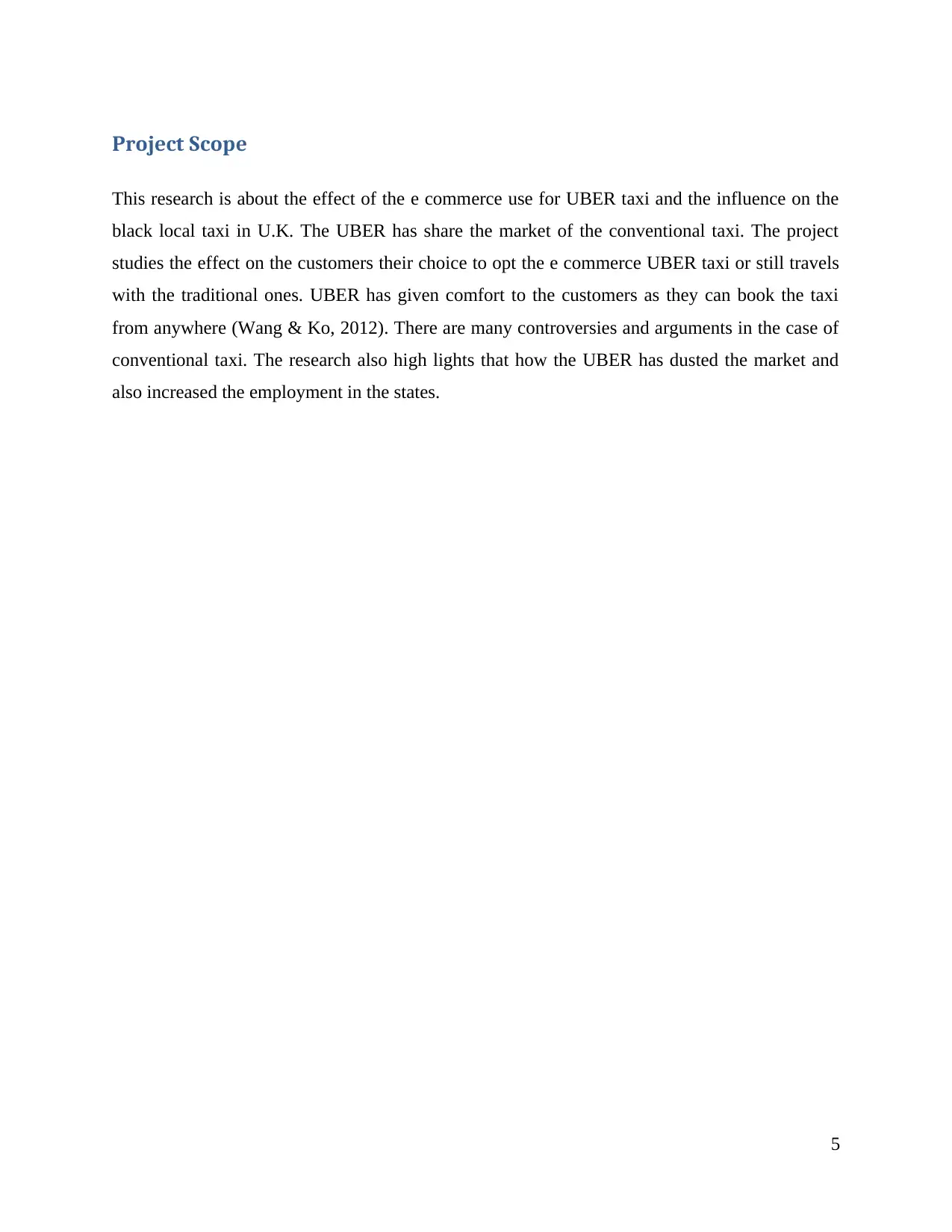
Project Scope
This research is about the effect of the e commerce use for UBER taxi and the influence on the
black local taxi in U.K. The UBER has share the market of the conventional taxi. The project
studies the effect on the customers their choice to opt the e commerce UBER taxi or still travels
with the traditional ones. UBER has given comfort to the customers as they can book the taxi
from anywhere (Wang & Ko, 2012). There are many controversies and arguments in the case of
conventional taxi. The research also high lights that how the UBER has dusted the market and
also increased the employment in the states.
5
This research is about the effect of the e commerce use for UBER taxi and the influence on the
black local taxi in U.K. The UBER has share the market of the conventional taxi. The project
studies the effect on the customers their choice to opt the e commerce UBER taxi or still travels
with the traditional ones. UBER has given comfort to the customers as they can book the taxi
from anywhere (Wang & Ko, 2012). There are many controversies and arguments in the case of
conventional taxi. The research also high lights that how the UBER has dusted the market and
also increased the employment in the states.
5
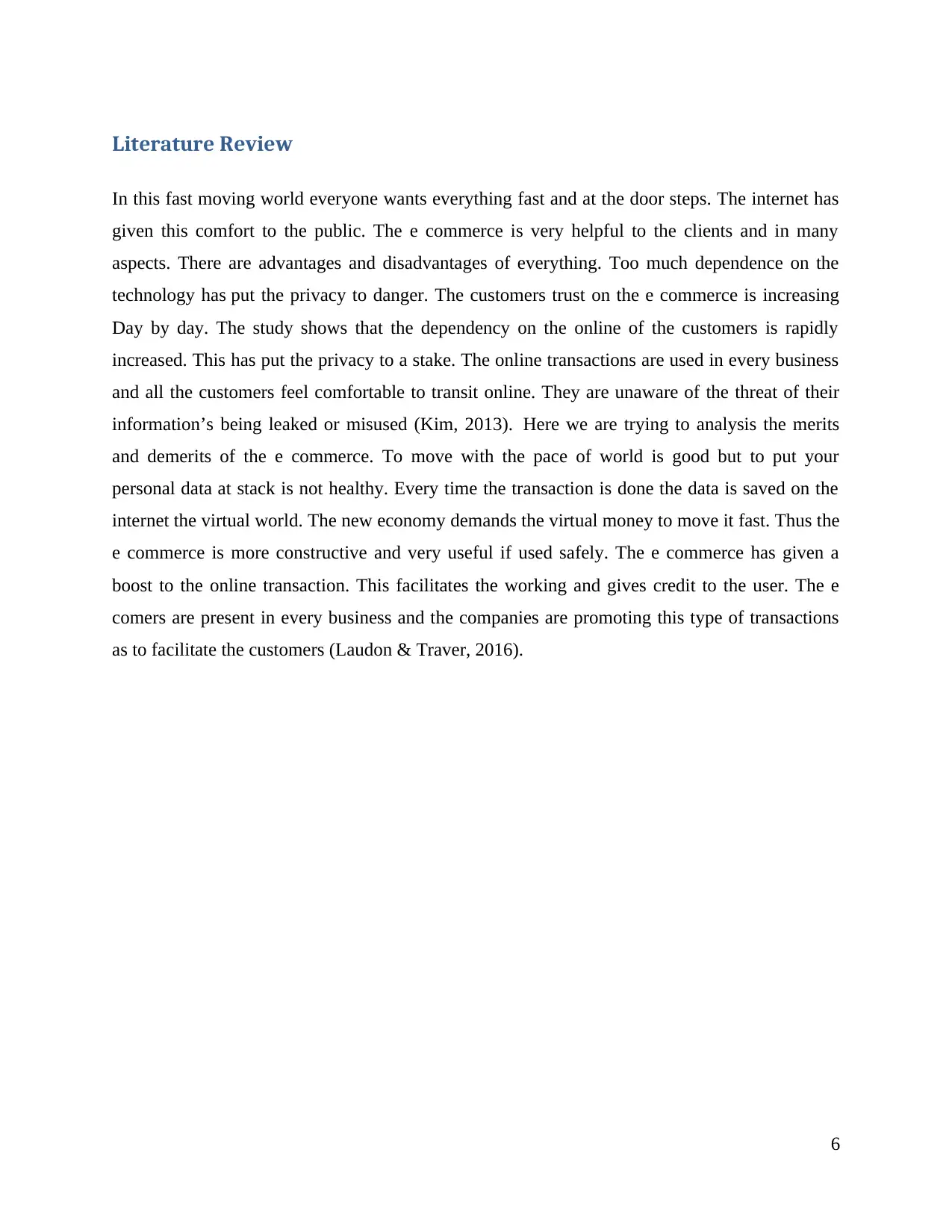
Literature Review
In this fast moving world everyone wants everything fast and at the door steps. The internet has
given this comfort to the public. The e commerce is very helpful to the clients and in many
aspects. There are advantages and disadvantages of everything. Too much dependence on the
technology has put the privacy to danger. The customers trust on the e commerce is increasing
Day by day. The study shows that the dependency on the online of the customers is rapidly
increased. This has put the privacy to a stake. The online transactions are used in every business
and all the customers feel comfortable to transit online. They are unaware of the threat of their
information’s being leaked or misused (Kim, 2013). Here we are trying to analysis the merits
and demerits of the e commerce. To move with the pace of world is good but to put your
personal data at stack is not healthy. Every time the transaction is done the data is saved on the
internet the virtual world. The new economy demands the virtual money to move it fast. Thus the
e commerce is more constructive and very useful if used safely. The e commerce has given a
boost to the online transaction. This facilitates the working and gives credit to the user. The e
comers are present in every business and the companies are promoting this type of transactions
as to facilitate the customers (Laudon & Traver, 2016).
6
In this fast moving world everyone wants everything fast and at the door steps. The internet has
given this comfort to the public. The e commerce is very helpful to the clients and in many
aspects. There are advantages and disadvantages of everything. Too much dependence on the
technology has put the privacy to danger. The customers trust on the e commerce is increasing
Day by day. The study shows that the dependency on the online of the customers is rapidly
increased. This has put the privacy to a stake. The online transactions are used in every business
and all the customers feel comfortable to transit online. They are unaware of the threat of their
information’s being leaked or misused (Kim, 2013). Here we are trying to analysis the merits
and demerits of the e commerce. To move with the pace of world is good but to put your
personal data at stack is not healthy. Every time the transaction is done the data is saved on the
internet the virtual world. The new economy demands the virtual money to move it fast. Thus the
e commerce is more constructive and very useful if used safely. The e commerce has given a
boost to the online transaction. This facilitates the working and gives credit to the user. The e
comers are present in every business and the companies are promoting this type of transactions
as to facilitate the customers (Laudon & Traver, 2016).
6
⊘ This is a preview!⊘
Do you want full access?
Subscribe today to unlock all pages.

Trusted by 1+ million students worldwide
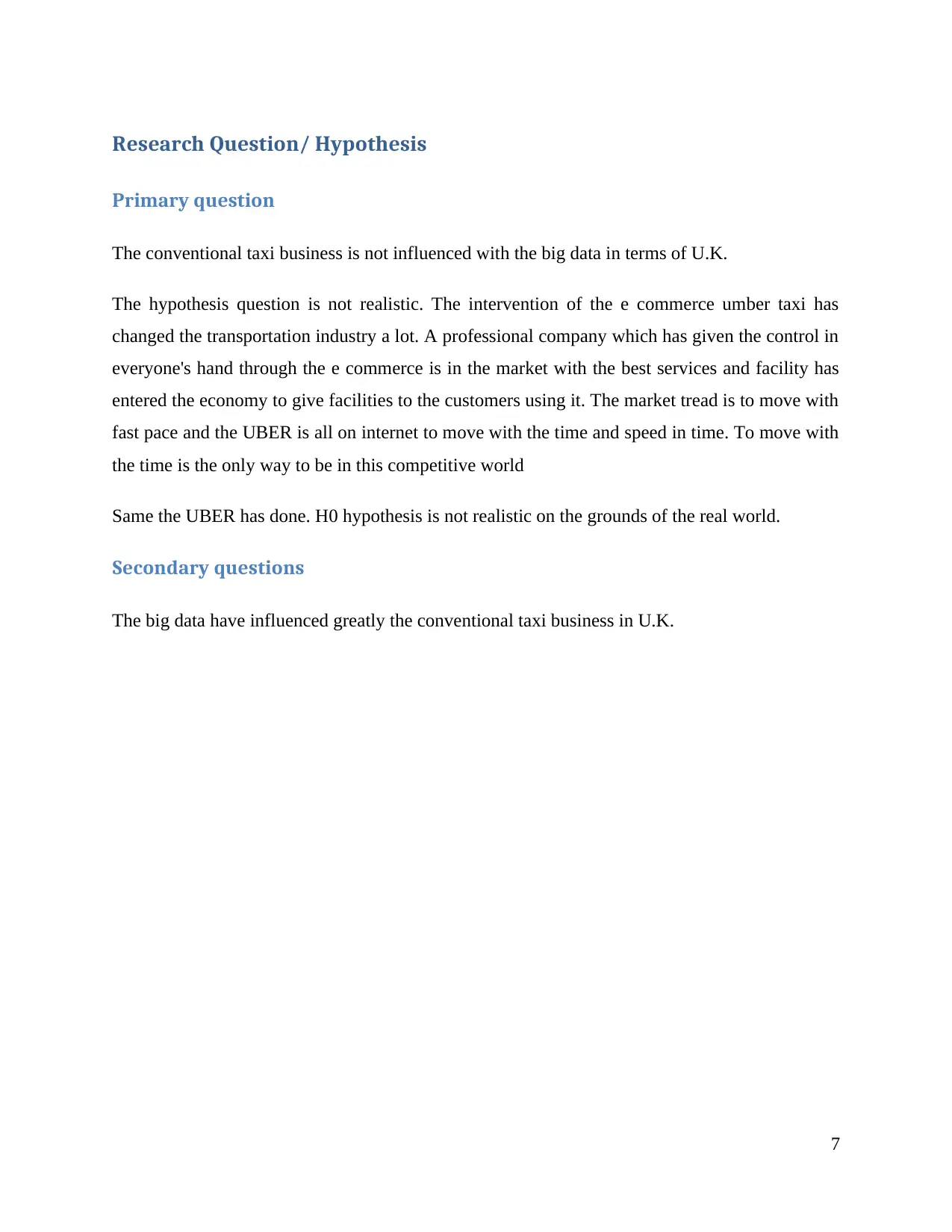
Research Question/ Hypothesis
Primary question
The conventional taxi business is not influenced with the big data in terms of U.K.
The hypothesis question is not realistic. The intervention of the e commerce umber taxi has
changed the transportation industry a lot. A professional company which has given the control in
everyone's hand through the e commerce is in the market with the best services and facility has
entered the economy to give facilities to the customers using it. The market tread is to move with
fast pace and the UBER is all on internet to move with the time and speed in time. To move with
the time is the only way to be in this competitive world
Same the UBER has done. H0 hypothesis is not realistic on the grounds of the real world.
Secondary questions
The big data have influenced greatly the conventional taxi business in U.K.
7
Primary question
The conventional taxi business is not influenced with the big data in terms of U.K.
The hypothesis question is not realistic. The intervention of the e commerce umber taxi has
changed the transportation industry a lot. A professional company which has given the control in
everyone's hand through the e commerce is in the market with the best services and facility has
entered the economy to give facilities to the customers using it. The market tread is to move with
fast pace and the UBER is all on internet to move with the time and speed in time. To move with
the time is the only way to be in this competitive world
Same the UBER has done. H0 hypothesis is not realistic on the grounds of the real world.
Secondary questions
The big data have influenced greatly the conventional taxi business in U.K.
7
Paraphrase This Document
Need a fresh take? Get an instant paraphrase of this document with our AI Paraphraser
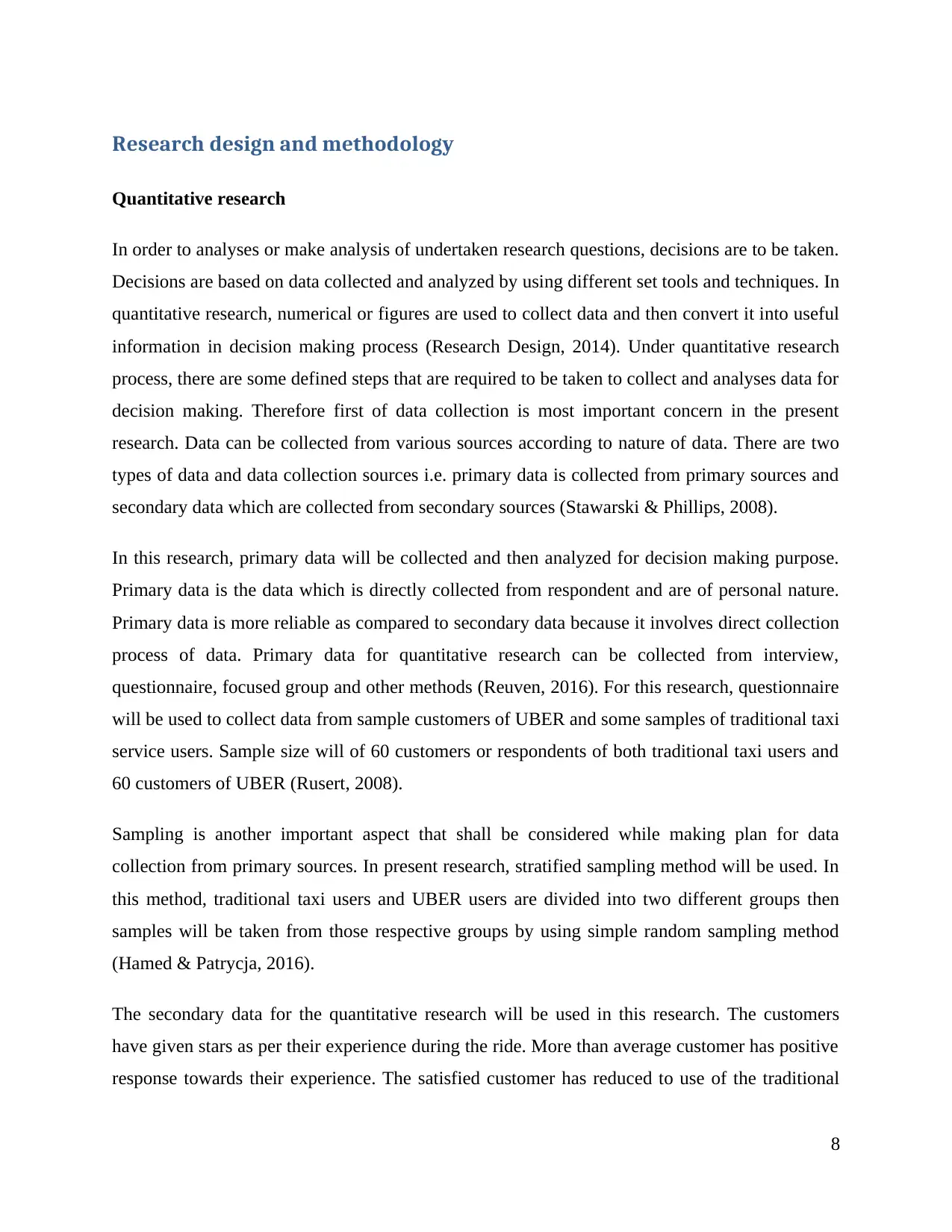
Research design and methodology
Quantitative research
In order to analyses or make analysis of undertaken research questions, decisions are to be taken.
Decisions are based on data collected and analyzed by using different set tools and techniques. In
quantitative research, numerical or figures are used to collect data and then convert it into useful
information in decision making process (Research Design, 2014). Under quantitative research
process, there are some defined steps that are required to be taken to collect and analyses data for
decision making. Therefore first of data collection is most important concern in the present
research. Data can be collected from various sources according to nature of data. There are two
types of data and data collection sources i.e. primary data is collected from primary sources and
secondary data which are collected from secondary sources (Stawarski & Phillips, 2008).
In this research, primary data will be collected and then analyzed for decision making purpose.
Primary data is the data which is directly collected from respondent and are of personal nature.
Primary data is more reliable as compared to secondary data because it involves direct collection
process of data. Primary data for quantitative research can be collected from interview,
questionnaire, focused group and other methods (Reuven, 2016). For this research, questionnaire
will be used to collect data from sample customers of UBER and some samples of traditional taxi
service users. Sample size will of 60 customers or respondents of both traditional taxi users and
60 customers of UBER (Rusert, 2008).
Sampling is another important aspect that shall be considered while making plan for data
collection from primary sources. In present research, stratified sampling method will be used. In
this method, traditional taxi users and UBER users are divided into two different groups then
samples will be taken from those respective groups by using simple random sampling method
(Hamed & Patrycja, 2016).
The secondary data for the quantitative research will be used in this research. The customers
have given stars as per their experience during the ride. More than average customer has positive
response towards their experience. The satisfied customer has reduced to use of the traditional
8
Quantitative research
In order to analyses or make analysis of undertaken research questions, decisions are to be taken.
Decisions are based on data collected and analyzed by using different set tools and techniques. In
quantitative research, numerical or figures are used to collect data and then convert it into useful
information in decision making process (Research Design, 2014). Under quantitative research
process, there are some defined steps that are required to be taken to collect and analyses data for
decision making. Therefore first of data collection is most important concern in the present
research. Data can be collected from various sources according to nature of data. There are two
types of data and data collection sources i.e. primary data is collected from primary sources and
secondary data which are collected from secondary sources (Stawarski & Phillips, 2008).
In this research, primary data will be collected and then analyzed for decision making purpose.
Primary data is the data which is directly collected from respondent and are of personal nature.
Primary data is more reliable as compared to secondary data because it involves direct collection
process of data. Primary data for quantitative research can be collected from interview,
questionnaire, focused group and other methods (Reuven, 2016). For this research, questionnaire
will be used to collect data from sample customers of UBER and some samples of traditional taxi
service users. Sample size will of 60 customers or respondents of both traditional taxi users and
60 customers of UBER (Rusert, 2008).
Sampling is another important aspect that shall be considered while making plan for data
collection from primary sources. In present research, stratified sampling method will be used. In
this method, traditional taxi users and UBER users are divided into two different groups then
samples will be taken from those respective groups by using simple random sampling method
(Hamed & Patrycja, 2016).
The secondary data for the quantitative research will be used in this research. The customers
have given stars as per their experience during the ride. More than average customer has positive
response towards their experience. The satisfied customer has reduced to use of the traditional
8
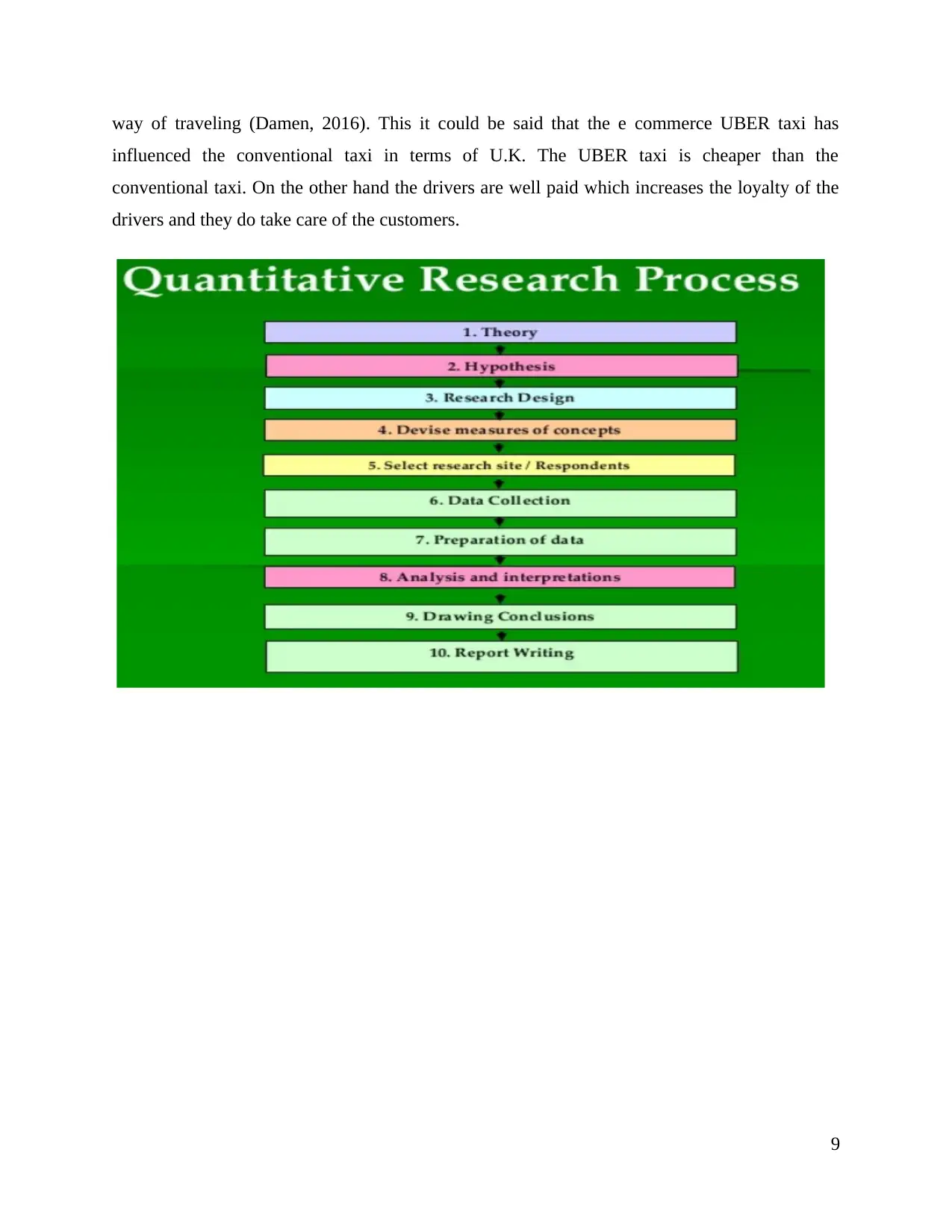
way of traveling (Damen, 2016). This it could be said that the e commerce UBER taxi has
influenced the conventional taxi in terms of U.K. The UBER taxi is cheaper than the
conventional taxi. On the other hand the drivers are well paid which increases the loyalty of the
drivers and they do take care of the customers.
9
influenced the conventional taxi in terms of U.K. The UBER taxi is cheaper than the
conventional taxi. On the other hand the drivers are well paid which increases the loyalty of the
drivers and they do take care of the customers.
9
⊘ This is a preview!⊘
Do you want full access?
Subscribe today to unlock all pages.

Trusted by 1+ million students worldwide
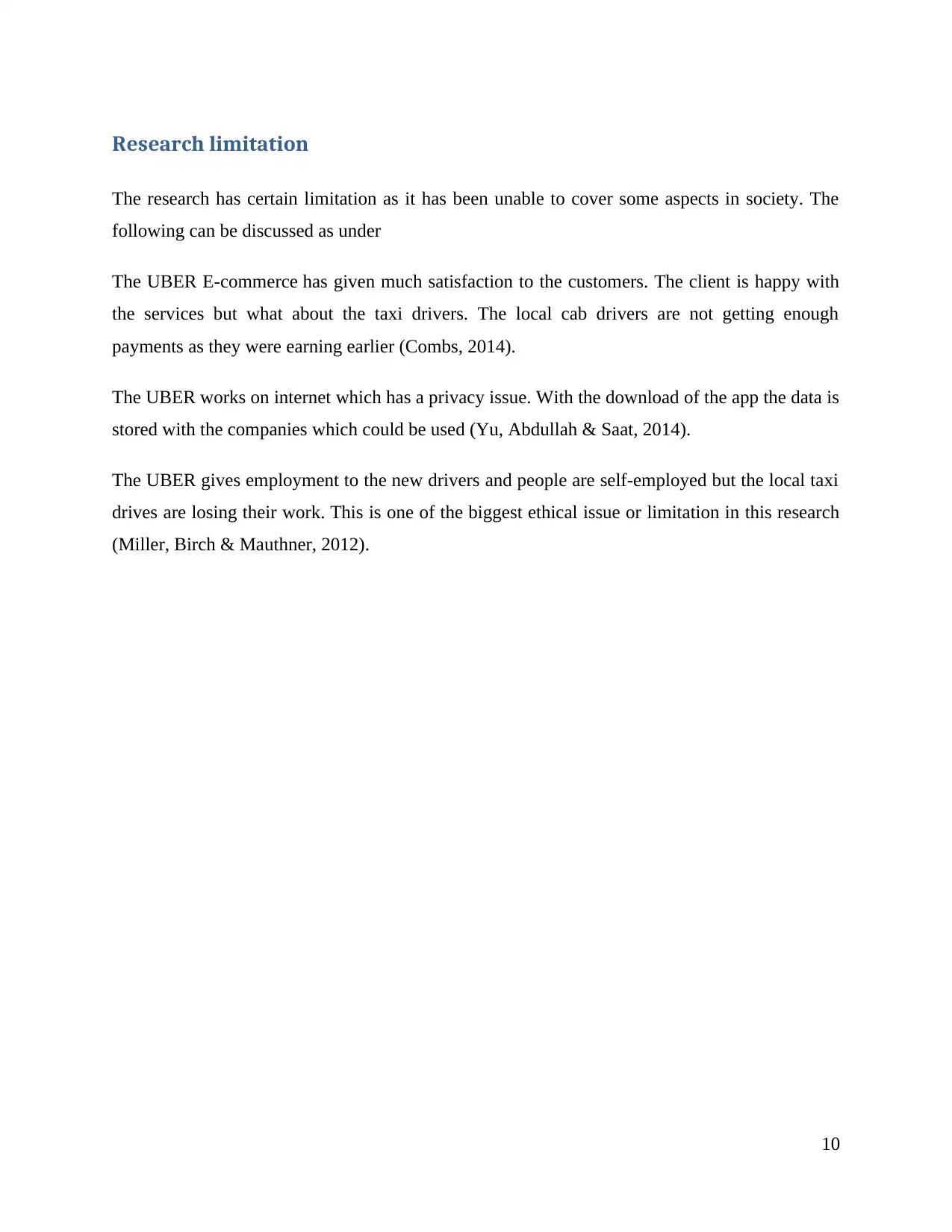
Research limitation
The research has certain limitation as it has been unable to cover some aspects in society. The
following can be discussed as under
The UBER E-commerce has given much satisfaction to the customers. The client is happy with
the services but what about the taxi drivers. The local cab drivers are not getting enough
payments as they were earning earlier (Combs, 2014).
The UBER works on internet which has a privacy issue. With the download of the app the data is
stored with the companies which could be used (Yu, Abdullah & Saat, 2014).
The UBER gives employment to the new drivers and people are self-employed but the local taxi
drives are losing their work. This is one of the biggest ethical issue or limitation in this research
(Miller, Birch & Mauthner, 2012).
10
The research has certain limitation as it has been unable to cover some aspects in society. The
following can be discussed as under
The UBER E-commerce has given much satisfaction to the customers. The client is happy with
the services but what about the taxi drivers. The local cab drivers are not getting enough
payments as they were earning earlier (Combs, 2014).
The UBER works on internet which has a privacy issue. With the download of the app the data is
stored with the companies which could be used (Yu, Abdullah & Saat, 2014).
The UBER gives employment to the new drivers and people are self-employed but the local taxi
drives are losing their work. This is one of the biggest ethical issue or limitation in this research
(Miller, Birch & Mauthner, 2012).
10
Paraphrase This Document
Need a fresh take? Get an instant paraphrase of this document with our AI Paraphraser
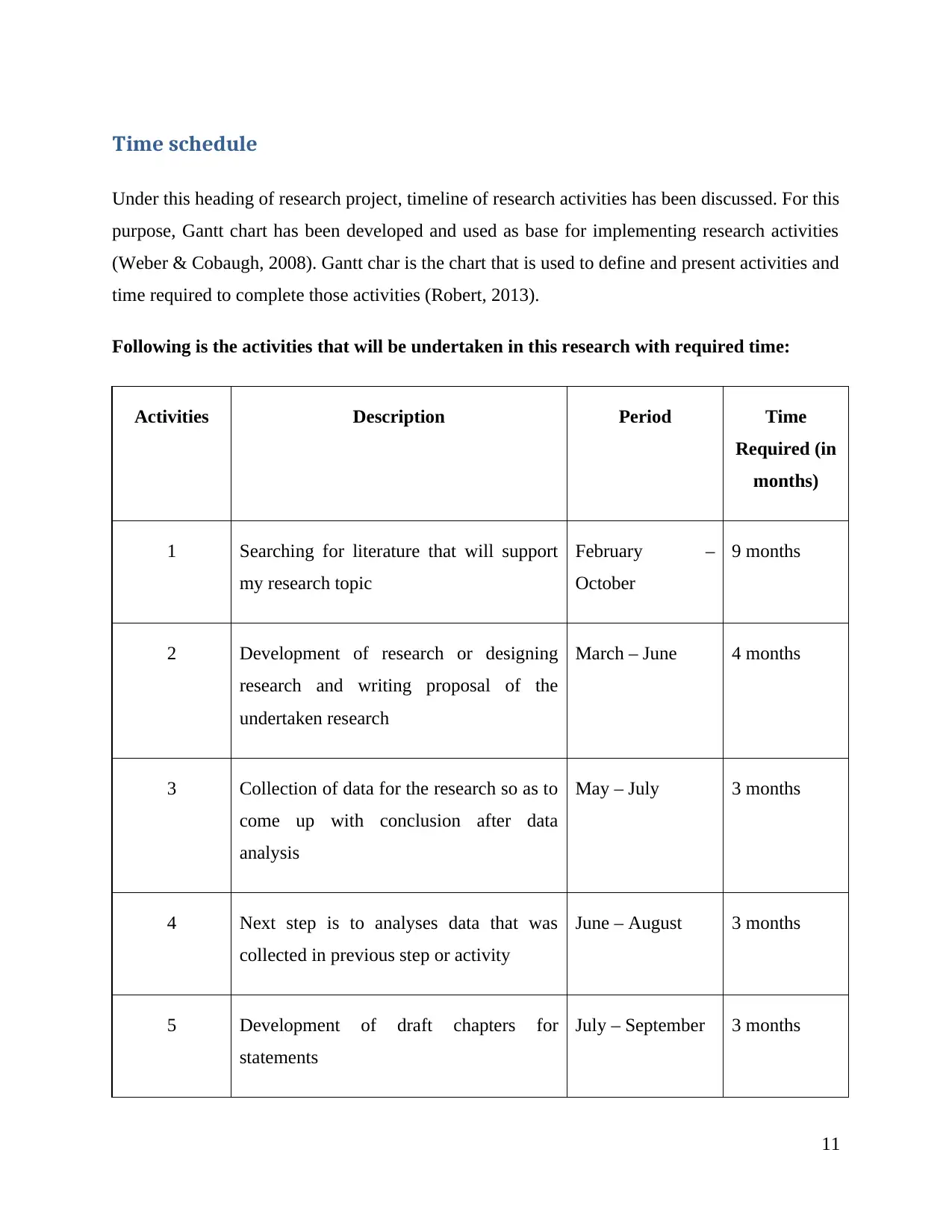
Time schedule
Under this heading of research project, timeline of research activities has been discussed. For this
purpose, Gantt chart has been developed and used as base for implementing research activities
(Weber & Cobaugh, 2008). Gantt char is the chart that is used to define and present activities and
time required to complete those activities (Robert, 2013).
Following is the activities that will be undertaken in this research with required time:
Activities Description Period Time
Required (in
months)
1 Searching for literature that will support
my research topic
February –
October
9 months
2 Development of research or designing
research and writing proposal of the
undertaken research
March – June 4 months
3 Collection of data for the research so as to
come up with conclusion after data
analysis
May – July 3 months
4 Next step is to analyses data that was
collected in previous step or activity
June – August 3 months
5 Development of draft chapters for
statements
July – September 3 months
11
Under this heading of research project, timeline of research activities has been discussed. For this
purpose, Gantt chart has been developed and used as base for implementing research activities
(Weber & Cobaugh, 2008). Gantt char is the chart that is used to define and present activities and
time required to complete those activities (Robert, 2013).
Following is the activities that will be undertaken in this research with required time:
Activities Description Period Time
Required (in
months)
1 Searching for literature that will support
my research topic
February –
October
9 months
2 Development of research or designing
research and writing proposal of the
undertaken research
March – June 4 months
3 Collection of data for the research so as to
come up with conclusion after data
analysis
May – July 3 months
4 Next step is to analyses data that was
collected in previous step or activity
June – August 3 months
5 Development of draft chapters for
statements
July – September 3 months
11
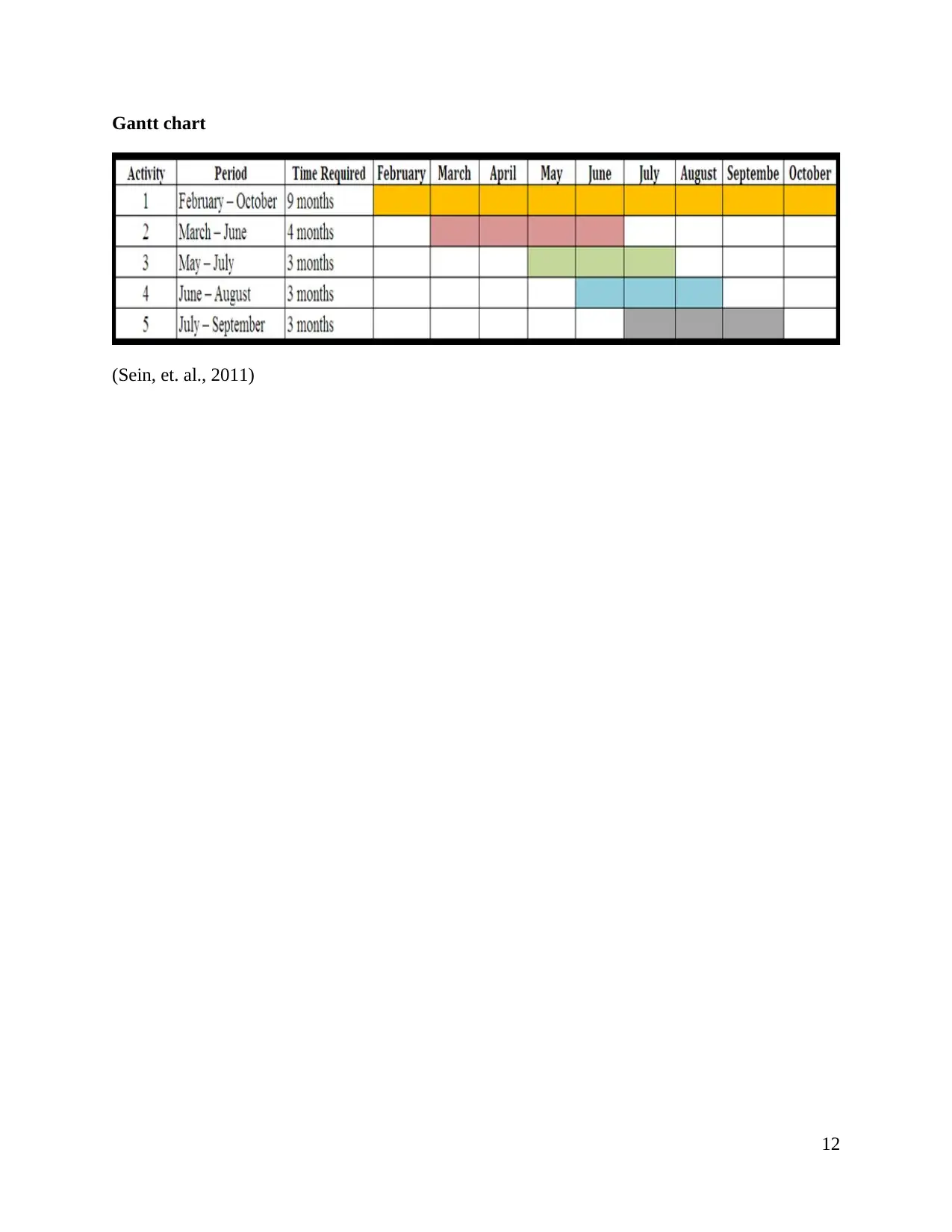
Gantt chart
(Sein, et. al., 2011)
12
(Sein, et. al., 2011)
12
⊘ This is a preview!⊘
Do you want full access?
Subscribe today to unlock all pages.

Trusted by 1+ million students worldwide
1 out of 15
Related Documents
Your All-in-One AI-Powered Toolkit for Academic Success.
+13062052269
info@desklib.com
Available 24*7 on WhatsApp / Email
![[object Object]](/_next/static/media/star-bottom.7253800d.svg)
Unlock your academic potential
Copyright © 2020–2025 A2Z Services. All Rights Reserved. Developed and managed by ZUCOL.





